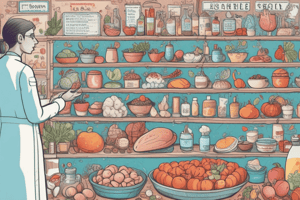Podcast
Questions and Answers
What is the primary reason for the decline in staphylococcal gastroenteritis outbreaks?
What is the primary reason for the decline in staphylococcal gastroenteritis outbreaks?
- Increased awareness about the disease
- Better use of refrigerated temperatures and improved sanitary practices (correct)
- Improved handling and storage of food
- Development of vaccines against Staphylococcus aureus
What is the temperature range for growth of Staphylococcus aureus?
What is the temperature range for growth of Staphylococcus aureus?
- 7 to 48°C (correct)
- 20 to 40°C
- 30 to 50°C
- 15 to 30°C
What is the primary characteristic that allows Staphylococcus aureus to grow in many foods?
What is the primary characteristic that allows Staphylococcus aureus to grow in many foods?
- Their ability to produce coagulase
- Their ability to ferment carbohydrates
- Their ability to cause proteolysis
- Their ability to grow under adverse conditions (correct)
What is the minimum water activity (Aw) required for Staphylococcus aureus to grow?
What is the minimum water activity (Aw) required for Staphylococcus aureus to grow?
What is the primary habitat of enterotoxin-producing Staphylococcus aureus strains?
What is the primary habitat of enterotoxin-producing Staphylococcus aureus strains?
What is the effect of combining two or more adverse parameters on the growth of Staphylococcus aureus?
What is the effect of combining two or more adverse parameters on the growth of Staphylococcus aureus?
What is the reason why Staphylococcus aureus are poor competitors to many other microorganisms in foods?
What is the reason why Staphylococcus aureus are poor competitors to many other microorganisms in foods?
What is the time it takes to kill Staphylococcus aureus at 66°C?
What is the time it takes to kill Staphylococcus aureus at 66°C?
What is the primary mechanism by which foodborne intoxication of microbial origin occurs?
What is the primary mechanism by which foodborne intoxication of microbial origin occurs?
Which of the following is a characteristic of food poisoning?
Which of the following is a characteristic of food poisoning?
What is the primary difference between enterotoxins and neurotoxins?
What is the primary difference between enterotoxins and neurotoxins?
What is the significance of staphylococcal food poisoning in the U.S.?
What is the significance of staphylococcal food poisoning in the U.S.?
What is the percentage of foodborne disease outbreaks attributed to staphylococcal food poisoning between 1972 and 1976?
What is the percentage of foodborne disease outbreaks attributed to staphylococcal food poisoning between 1972 and 1976?
What is the significance of the heat stability of a toxin in foodborne intoxication?
What is the significance of the heat stability of a toxin in foodborne intoxication?
What is the primary difference between staphylococcal food poisoning and infant botulism?
What is the primary difference between staphylococcal food poisoning and infant botulism?
What is the primary characteristic of the symptoms of foodborne intoxication?
What is the primary characteristic of the symptoms of foodborne intoxication?
What is the primary source of food contamination by Sta. aureus?
What is the primary source of food contamination by Sta. aureus?
Which of the following is NOT a characteristic of enterotoxins produced by Sta. aureus?
Which of the following is NOT a characteristic of enterotoxins produced by Sta. aureus?
What is the optimum temperature range for the growth of Sta. aureus?
What is the optimum temperature range for the growth of Sta. aureus?
What is the minimum population density required for toxin detection in food?
What is the minimum population density required for toxin detection in food?
What is the minimum amount of toxin required to cause symptoms in a healthy adult?
What is the minimum amount of toxin required to cause symptoms in a healthy adult?
What is the range of time for symptoms to occur after consuming contaminated food?
What is the range of time for symptoms to occur after consuming contaminated food?
What is the primary effect of toxins on the autonomic nervous system?
What is the primary effect of toxins on the autonomic nervous system?
What is the usual duration of the disease caused by Sta. aureus toxins?
What is the usual duration of the disease caused by Sta. aureus toxins?
What types of foods are more frequently associated with staphylococcal gastroenteritis?
What types of foods are more frequently associated with staphylococcal gastroenteritis?
What is the primary reason why Staphylococcus aureus grows in food?
What is the primary reason why Staphylococcus aureus grows in food?
What is the percentage of outbreaks attributed to improper holding temperature?
What is the percentage of outbreaks attributed to improper holding temperature?
What is the month range during which a high percentage of staphylococcal gastroenteritis outbreaks occur?
What is the month range during which a high percentage of staphylococcal gastroenteritis outbreaks occur?
What is the source of staphylococcal gastroenteritis outbreaks in the case of imported foods?
What is the source of staphylococcal gastroenteritis outbreaks in the case of imported foods?
What is the characteristic of Staphylococcus aureus toxins that allows them to remain potent after canning?
What is the characteristic of Staphylococcus aureus toxins that allows them to remain potent after canning?
What is the primary source of staphylococcal gastroenteritis outbreaks in terms of where the food was prepared or served?
What is the primary source of staphylococcal gastroenteritis outbreaks in terms of where the food was prepared or served?
What is the reason why it is impossible to produce foods that are completely free of Staphylococcus aureus?
What is the reason why it is impossible to produce foods that are completely free of Staphylococcus aureus?
What is the likely source of the Staphylococcus aureus pathogen in the food poisoning outbreak?
What is the likely source of the Staphylococcus aureus pathogen in the food poisoning outbreak?
What is the primary factor that contributed to the growth of Staphylococcus aureus in the turkey?
What is the primary factor that contributed to the growth of Staphylococcus aureus in the turkey?
What is the primary symptom of botulism?
What is the primary symptom of botulism?
How does infant botulism occur?
How does infant botulism occur?
What is the effect of prompt treatment on botulism?
What is the effect of prompt treatment on botulism?
What is the characteristic of Clostridium botulinum that makes it a potent toxin?
What is the characteristic of Clostridium botulinum that makes it a potent toxin?
What is the likely outcome of consuming food contaminated with Clostridium botulinum?
What is the likely outcome of consuming food contaminated with Clostridium botulinum?
Why did the turkey not show any adverse acceptance quality despite being contaminated with Staphylococcus aureus?
Why did the turkey not show any adverse acceptance quality despite being contaminated with Staphylococcus aureus?
Flashcards are hidden until you start studying
Study Notes
Foodborne Intoxications
- Foodborne intoxication occurs when a food containing a preformed toxin is ingested, resulting in poisoning.
- Two types of foodborne intoxications are discussed: staphylococcal intoxication and botulism.
- General characteristics of food poisoning include:
- The toxin is produced by a pathogen while growing in a food.
- A toxin can be heat labile or heat stable.
- Ingestion of a food containing active toxin, not viable microbial cells, is necessary for poisoning (except for infant botulism).
- Symptoms generally occur quickly, as early as 30 minutes after ingestion.
- Symptoms differ with type of toxin; enterotoxins produce gastric symptoms and neurotoxins produce neurological symptoms.
- Febrile symptoms are not present.
Staphylococcal Intoxication
- Importance:
- Staphylococcal food poisoning is one of the most frequently occurring foodborne diseases worldwide.
- It was implicated in many outbreaks in the US before the 1980s, but the number of outbreaks has declined in recent years.
- Characteristics of Staphylococcus aureus:
- Organisms:
- Gram-positive cocci, nonmotile, noncapsular, and nonsporulating.
- Growth:
- Most strains ferment mannitol and produce coagulase, thermonuclease, and hemolysin.
- Cells are killed at 66°C in 12 minutes, and at 72°C in 15 seconds.
- Facultative anaerobes, growing rapidly under aerobic conditions.
- Can ferment carbohydrates and cause proteolysis by extracellular proteolytic enzymes.
- Grow at relatively low Aw (0.86), low pH (4.8), and high salt and sugar concentrations.
- Habitat:
- Enterotoxin-producing Sta. aureus strains are associated with staphylococcal food intoxication.
- Naturally present in the nose, throat, skin, and hair of healthy humans, animals, and birds.
- Organisms:
- Toxins and Toxin Production:
- Enterotoxigenic strains produce seven different enterotoxins: A, B, C1, C2, C3, D, and E.
- Heat-stable proteins, differing in toxicity.
- Normal temperature and time used to process or cook foods do not destroy the potency of the toxins.
- Optimum growth occurs at 37 to 40°C.
- Toxins can be detected when a population has reached over a few million per gram or milliliter of food, generally in 4 hours.
- Disease and Symptoms:
- Staphylococcal toxins cause gastroenteritis, with symptoms occurring within 2 to 4 hours.
- Symptoms include salivation, nausea, vomiting, abdominal cramps, and diarrhea.
- Secondary symptoms include sweating, chills, headache, and dehydration.
- Food Association:
- Many foods have been implicated in staphylococcal foodborne outbreaks, including corned beef, salami, barbecued meat, salads, baking products, and cheeses.
- Three major contributing factors in outbreaks were improper holding temperature, poor personal hygiene, and contaminated equipment.
- Prevention (Reduction) of the Disease:
- Impossible to produce foods that are free of Sta. aureus.
- Prevention involves proper handling, cooking, and storage of foods to prevent growth and toxin production.
Botulism
- Importance:
- Botulism results from consuming food containing the potent toxin botulin of Clostridium botulinum.
- It is a neurotoxin, producing neurological symptoms along with some gastric symptoms.
- Unless prompt treatment is administered, it is quite fatal.
- Characteristics:
- Organisms:
- Cells of Clostridium botulinum are... (incomplete sentence)
- Organisms:
Studying That Suits You
Use AI to generate personalized quizzes and flashcards to suit your learning preferences.




